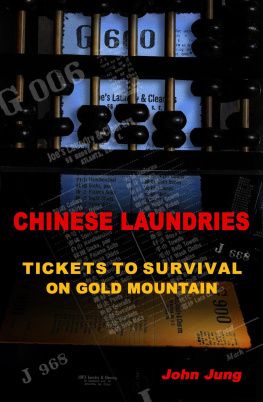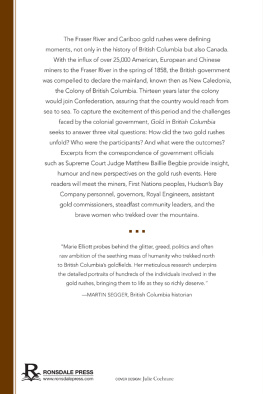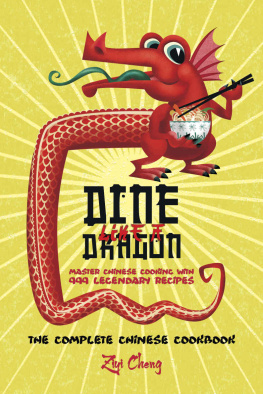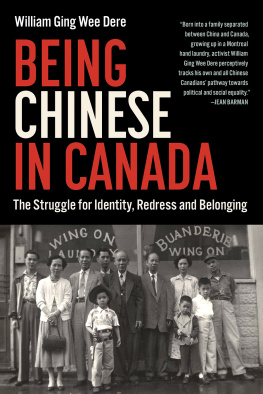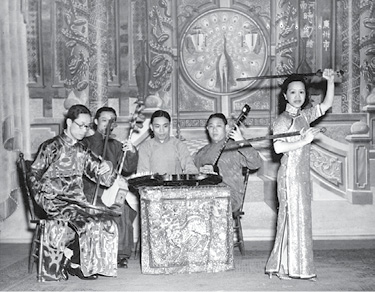Great Fortune Dream
The Struggles and Triumphs of Chinese Settlers in Canada, 18581966
David Chuenyan Lai and Guo Ding
Caitlin Press
Copyright 2016 David Chuenyan Lai and Guo Ding
All rights reserved. No part of this publication may be reproduced, stored in a retrieval system or transmitted, in any form or by any means, without prior permission of the publisher or a licence from Access Copyright, the Canadian Copyright Licensing Agency, www.accesscopyright.ca, 1-800-893-5777, info@accesscopyright.ca.
Caitlin Press Inc.
8100 Alderwood Road, Halfmoon Bay, BC,
V0N 1Y1
www.caitlin-press.com
Cover design by Vici Johnstone
Edited by Catherine Edwards and Kathleen Fraser
Ebook by Demian Pettman
Caitlin Press Inc. acknowledges financial support from the Government of Canada and the Canada Council for the Arts, and from the Province of British Columbia through the British Columbia Arts Council and the Book Publishers Tax Credit. We would also like to thank The Peoples Publishing House of Beijing, China, for their generous support.
Library and Archives Canada Cataloguing in Publication
Lai, David Chuenyan, 1937-, author
Great fortune dream : the struggles and triumphs of Chinese settlers in Canada, 1858-1966 / David Chuenyan Lai, Guo Ding.
ISBN 978-1-987915-03-7 (paperback)
Includes bibliographical references and index.
ISBN 978-1-987915-30-3 (ebook)
1. ChineseCanadaHistory. 2. Chinese CanadiansHistory. 3. ChineseCanadaSocial conditions. 4. Chinese CanadiansSocial conditions. 5. ChineseGovernment policyCanada. 6. CanadaEmigration and immigrationGovernment policy. 7. Race discriminationCanada. 8. CanadaRace relations. I. Guo, Ding, author II. Title.
FC106.C5C67 2015 971'.004951 C2015-904044-2
Dedicated to all Canadians whose stories have not yet been told.
Miss Koo-Yu-Ching dances to a Chinese orchestra, 1938. City of Vancouver Archives, Port P824.
Acknowledgements
The authors wish to thank Sarah Tang, MA, Beijing Foreign Studies University, and Liang He, MA, University of Warwick, for their initial translation of the Chinese text. Both of them are experienced translators. The authors also wish to extend their gratitude to Jia (Bobbie) Bao Heng for her hard work in reducing the Chinese volume, and proofreading and improving the initial rough translation. The authors also wish to thank the many Chinese community leaders who agreed to be interviewed and who provided research materials for the book. Thanks are also extended to the Peoples Publishing House, Beijing, who provided financial support for the translation through the Classic Chinese International Publication Program. Last but not the least, the two authors wish to deeply thank Vici Johnstone, Catherine Edwards, and Jia (Bobbie) Bao Heng for spending a great deal of time and effort even during the holiday season to complete this volume in time for spring 2016 publication.
David Chuenyan Lai
Guo Ding
Preface
The history of Chinese immigration to Canada can be divided into two periods. From 1858 to 1966, the Chinese entering Canada experienced discrimination and segregation. After 1967, federal immigration policy shifted, allowing Chinese immigrants to enter Canada on the same basis as other immigrants. Canada also adopted its current policy of multiculturalism, responding to changing attitudes towards Asian immigrants, and enabling the Chinese to become integrated into the mainstream of Canadian society. This volume covers the first part of the Chinese experience in Canada.
This story of the Chinese in Canada reflects on and challenges the discrimination and negative stereotypes that plagued Chinese communities in Canada before 1967. The recent research into peoples migration that inspired this book reassesses the policies and attitudes adopted by the host country, Canada, according to contemporary standards, contributing to a more profound analysis of the experiences of migrant people than has been the case in past historical studies. It is an interdisciplinary study that draws on history, geography, anthropology, and statistics to paint a comprehensive picture of Chinese experiences within mainstream Canadian society in the past, and to allow todays readers to appreciate the historically significant and valuable contributions the overseas Chinese made to the development of Canada. Interviews with the descendants of Chinese immigrants and both Chinese and English-language archival materials supplement and bring to life the experiences of the Chinese in this country.
A note here about the romanization of Chinese words: if there is an English romanization commonly in use, we have used that. If there is no widely accepted romanization, we have used the Pinyin system, which is in common use today. An example can be seen in the name of one of the authors. Lai Chuenyan is in common use, whereas the Pinyin system would romanize his name as Li Quanen. Since the latter has not been used in any of his publications, we have used the commonly used romanization.
The book, originally written in Chinese by Dr. David Chuenyan Lai, Dingguo, and Jia Bao Heng, was published in 2013 by the Peoples Publishing House in Beijing. The present volume is an English translation of the abridged Chinese volume by David Chuenyan Lai and Dingguo, adapted for a Canadian readership.
The Chinese Journey
The Chinese people today represent the largest ethnic group in the world. The Chinese are also among the largest groups of migrants. In the early years of the twenty-first century, it is estimated that there are between forty-five and sixty million ethnic Chinese people living in 150 countries outside of China, Taiwan, Hong Kong, and Macau. Although Chinese emigration to the outside world dates back more than two thousand years, it was only in the middle of the nineteenth century that mass migration of the Chinese began. This mass migration in the years from about 1850 to 1950 has come to be known as the Chinese diasporathe dispersion of the Chinese from their homeland. Some of these migrating Chinese came to Canada; in 1961, there were fifty-eight thousand Chinese people living in Canada, and today more than 1.5 million people with Chinese ancestry make Canada their home.
After the nineteenth-century Opium Wars between Britain and China ended, the Chinese began to emigrate in large groups to North America, at first to San Francisco to take part in the California gold rush and later to Canadas west coast when gold was also discovered in British Columbia. Most of the Chinese who migrated to Canada came from Siyi (the Four Counties of Taishan, Xinhui, Kaiping, and Enping) and Sanyi (the Three Counties of Nanhai, Panyu, and Shunde) in the Zhujiang Delta (Pearl River Delta) in Guangdong Province. At this time, Hong Kong and Canton (Guangzhou) were the two cities with the strongest British presence. People in these cities learned about North America, and the rural people of the Pearl River Delta in turn learned about it from these city people. A chain migration process led to people from all the counties on the delta emigrating to North America.


